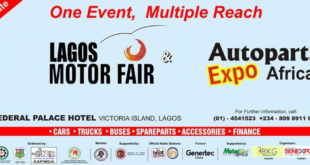 A new report by the Automotive Industry Export Council (AIEC) of South Africa has highlighted how COVID-19 impacted the automobile sector in the country in 2020. The report released by Dr. Norman Lamprecht of AIEC explained the visible effects of COVID19 on the South African automotive industry’s performance as the country had and is still having its fair share of the effects of the global pandemic.
A new report by the Automotive Industry Export Council (AIEC) of South Africa has highlighted how COVID-19 impacted the automobile sector in the country in 2020. The report released by Dr. Norman Lamprecht of AIEC explained the visible effects of COVID19 on the South African automotive industry’s performance as the country had and is still having its fair share of the effects of the global pandemic.
.According to the new report, the total automotive export value declined by a substantial R26 billion, or 12,9%, from the record R201,7 billion in 2019 to R175,7 billion in 2020, but still accounted for 13,9% of total South African exports. Vehicle exports also declined by a massive 115 804 units to 271 288 units in 2020, from the record 387 092 vehicles exported in 2019, with the export value declining by R26,8 billion from the R148,0 billion in 2019 to R121,2 billion in 2020.
On the upside, opportunities always present themselves in every circumstance, and automotive component exports reflected an increase of R0,8 billion to a record R54,5 billion in 2020 from the R53,7 billion in 2019 due to record catalytic converter exports of R25,98 billion, mainly to Europe in line with stricter emissions legislation implemented in the region in 2020.
The domestic automotive industry’s number of export destinations decreased to 147 countries in 2020 from the 151 destinations in 2019.
In 2020, the broader automotive industry’s contribution to the gross domestic product [GDP] stood at 4,9% [2,8% manufacturing and 2,1% retail], down from 6,4% in 2019, reflecting the severe impact of the COVID19 hard lockdown restrictions on automotive manufacturing and retail during the year. As the largest manufacturing sector in the country’s economy, a substantial 18,7% of value addition within the domestic manufacturing output was derived from vehicle and automotive component manufacturing activity, continuing to position the industry and its broader value chain as a key player within South Africa’s industrialisation landscape. The automotive sector remained one of the most visible sectors receiving foreign direct investments, with the seven OEMs investing a record R9,2 billion in 2020, while the component sector invested R2,4 billion in 2020. Investment at this scale is significant and will promote local value-addition, while importantly, technology is also embodied in the investment.
The domestic automotive industry’s overall top export markets in value terms in 2020 were Germany, with R56 billion, followed by the USA, the UK and Belgium. Of interest is that countries such as the Czech Republic, Russia, Morocco, and Egypt appeared under the 22 countries to which exports more than doubled on a yearon-year basis in 2020. The UK, with 67 798 vehicles, was once again South Africa’s top destinations for vehicle exports in 2020. Volkswagen, with its Polo model, topped the country’s export rankings in 2020. South Africa remains a strategic supplier of catalytic converters to the world, and by value, this component category maintained its dominant export position under the APDP in 2020 as the focus of exporters tends to be on high-value locally beneficiated, logistics-friendly automotive components.
The trade arrangements that South Africa enjoy enhanced exports and the EU, with exports of R105 billion, or 59,8% of the total export value of R175,7 billion, was the domestic automotive industry’s main export region in 2020. Three out of every four South African manufactured vehicles exported in 2020 were destined for Europe. Africa was the industry’s second largest export region with an export value of R29,6 billion, or 16,9% of the industry’s total export value of which 81,2% of the R29,6 billion was destined for SADC, which is a free trade area. Considering that regional market demand is one of the key pillars of the South African Automotive Masterplan [SAAM] 2021-2035, the African Continental Free Trade Area [AfCFTA] implemented on 1 January 2021 could unlock many opportunities for South Africa in expanding exports to the rest of the continent.
On the import side the top country of origin for vehicle imports in 2020 was India, with 87 953 units, or 43,2% of total passenger car and light commercial vehicles imported from India. The country has been established by several global brands as a production hub for entry-level and small vehicles, and most of the vehicles imported from India fell into these categories. Volkswagen’s Polo Vivo was the only vehicle in these segments that was manufactured in South Africa in 2020. The automotive policy regime in South Africa encourages domestic OEMs to manufacture high volumes of selected models linked to export contracts to obtain economies of scale, coupled with low-volume models imported to complement domestic market mixes. South Africa has one of the most competitive trading environments in the world, and in 2020 offered consumers a choice of no fewer than 43 passenger car brands and 3 132 model derivatives, the widest choice of new cars to market size ratio in the world.
Nine of the top 10 selling vehicles in 2020 were South African-built passenger cars and light commercial vehicles. The Toyota Hilux, with 31 263 units, was the most popular model sold in the country in 2020, followed by sales of 19 750 units by the top-selling passenger car, the Volkswagen Polo Vivo. An interesting phenomenon is that South African motorists are more inclined to rather drive bakkies, which have both commercial and leisure vehicle applications, than passenger cars.
Original equipment [OE] component imports by the seven vehicle manufacturers in South Africa declined to R82,3 billion in 2020, down by 22,9%, from the R106,8 billion in 2019, in line with the substantial 29,2% yearon-year decline in vehicle production in the country due to the impact of COVID-19 on new vehicle sales, exports and vehicle production. Germany, Thailand, Japan, and the US represented the main countries of origin for these components. High value, capital-intensive componentry, such as the powertrain and telematics, which collectively account for about 50% to 60% of the value in a modern vehicle, are mainly imported into South Africa and the remainder sourced in the domestic market. Global sourcing principles apply, which mean that every vehicle manufacturer sources a specific component from a specific globally recognisable brand component supplier.
Demand for replacement parts in South Africa remains high as 75% of the country’s vehicle parc is older than five years. Given the weak macro-economic climate in the country over an extended period, consumers tend to keep their cars for longer while the growing variety of models and more complex technologies in vehicles have also led to increasing demand for aftermarket parts.
Global vehicle production declined by a massive 15,8% to reach 77,62 million vehicles, down from 92,18 million units produced in 2019. South Africa’s global vehicle production ranking remained at 22nd in 2020, although its market share declined from 0,69% in 2019 to 0,58% in 2020. In terms of global LCV production, South Africa was ranked 15th with a market share of 1,08%. South Africa remained the dominant market on the African continent and accounted for 62,1% of total African vehicle production of 720 156 vehicles.
The global pandemic rocked the world to its very foundations, and ultimately there are no easy solutions to reigniting COVID-19 affected economies, with South Africa no exception to this. What promised to be a high point for the domestic automotive industry in 2020, with the APDP reaching the peak of its eight-year path, was annihilated by the global pandemic. COVID-19 has also resulted in the postponement of the South African automotive industry’s journey to 2035 under the South African Automotive Masterplan [SAAM] 2021 – 2035, by six months, from 1 January 2021 to 1 July 2021.
Encouraging news is that the world economy is projected to recover in 2021, while it is also expected that South Africa’s economic growth rate will rebound in 2021, setting the stage for a robust recovery from the very low base in 2020. In terms of the domestic automotive industry’s recovery, much will depend on the recovery of its main trading partners. The three main factors likely to determine the trajectory of the global economy in 2021 include the path of the pandemic and how it is managed; the vaccine and how it is rolled out; and the actions of governments in response to the pandemic. Despite everything, 2021 promises to be an exciting year for the automotive industry in South Africa in its journey to 2035.
 ..:: AUTO REPORT AFRICA ::..
..:: AUTO REPORT AFRICA ::..




